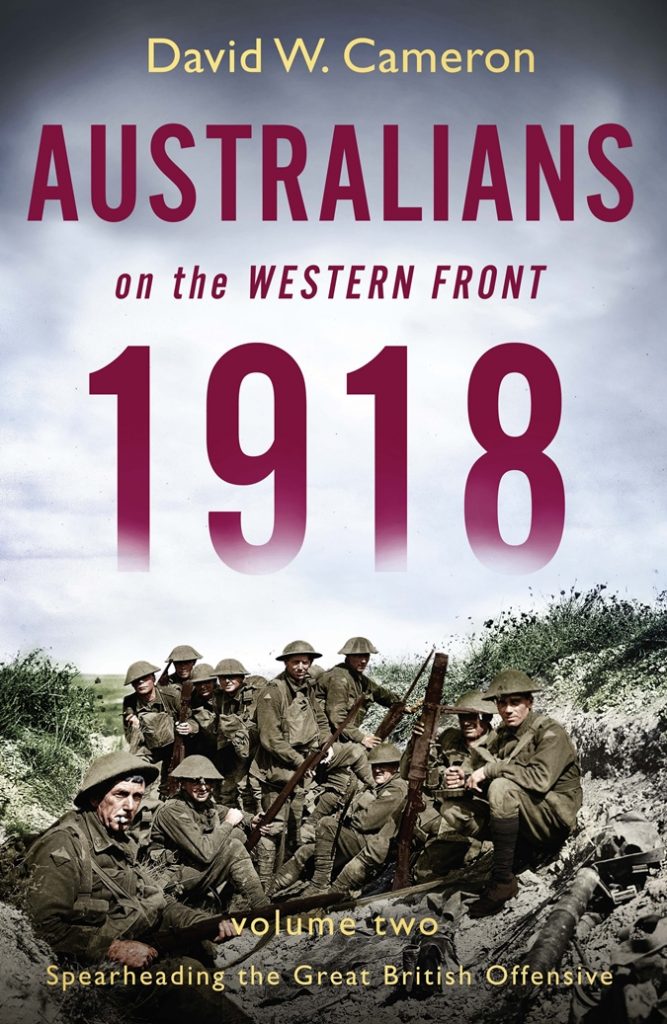After reading (and reviewing) David Cameron’s Australians on the Western Front 1918 Vol 1, my expectations of Vol 2 were more than realized. Twenty-five per cent longer, the detailed account from the Australian troops contribution to the Offensive from July to October 2018 makes for riveting reading.

Paperback 560pp RRP: $34.99
Using the same format as Vol 1, Cameron has tabled all Australian commanders down to the 60 battalion commanding officers and alluded to individuals mentioned in the narrative by their age, civilian occupation and hometown, as well as any bravery award(s) and their survival or otherwise of the conflict. The included disposition of individual rifle companies during attacks and reorganizations will enable descendants to place exactly where their forebear(s) were when the going was toughest.
Since the German Spring offensive, the nature of the conflict had changed, as had the ‘balance of power’. The Allies now had little problem with manpower and logistics as the US threw its support into the conflict. Conversely the German armies were heavily dependent on rail transport and were confronted with huge manpower and food shortages and logistic difficulties as well as coping with sinking morale. This did not in any way diminish the Allied casualties in any of the final battles, even though many Germans surrendered without providing strong opposition. Over 400 Australians died on 5th October at their last battle at Montbrehain before the Corps was taken from the Front.
The five battles covered are Hamel (4th July), Amiens (8th – 12th August), Chuignes (23rd August), Mont Saint-Quentin – Péronne (31st August – 5th September) and breaking through the Hindenberg Line and the subsequent Le Catelet and Beaurevoir Lines (29 September – 5 October).
Monash’s 4th July 93-minute battle in capturing le Hamel became the Allied model for the ‘last 100 days’. Generally, aerial reconnaissance and artillery bombardment preceded attacks that were accompanied by tank support that was most effective against wire obstacle and machinegun posts. Tank carriers were used in immediate post-action situations – ‘four carriers in 30 minutes landed defence stores, ammunition and water (that would have taken 1200 men all day)’ on a newly captured objective. Combatants could now be provided with a hot meal within a couple of hours after an action.
The 1916 and 1917 failed conscription referenda in Australia underlined the fact that there were no reinforcements (apart from previously wounded returning to units) to replace Australian losses during ongoing campaigns. The Australian government wanted bring home on a three-month furlough those who had enlisted in 1914 as well as having the fifteen Australian brigades conform to their British counterparts and consist of three (instead of the current four) battalions. Monash was forced to order, on 23 September 1918, the disbandment of seven depleted battalions to be merged with others. There were strong objections by those who had enlisted on hearing that their beloved battalions were to be broken up. Negotiations between battalion representatives and divisional and brigade staff resolved matters ‘satisfactorily’, albeit temporarily, before Monash’s Corps attacked the Hindenberg Line.
Included are a comprehensive range of photographs include the wire and fortified posts protecting objectives, captured fortifications, VC winners, and Prime Minister Billy Hughes at the Front. Included are 30 pages of Notes, eleven pages of References, an 18-page General Index and a six-page Index of Military Units. Eight excellent battle maps cover all the details of the actions listed above.
This extremely readable and extensively researched account will be a fine addition to Australian military history collections.
Reviewed for RUSIV by Neville Taylor, October 2018
Contact Royal United Services Institute about this article.






